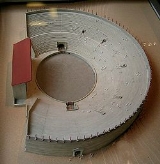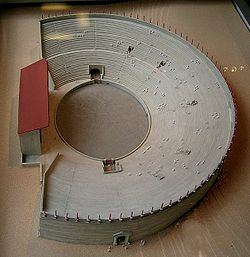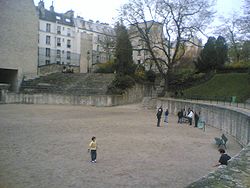
Arènes de Lutèce
Encyclopedia



Paris
Paris is the capital and largest city in France, situated on the river Seine, in northern France, at the heart of the Île-de-France region...
(formerly known as Lutèce
Lutetia
Lutetia was a town in pre-Roman and Roman Gaul. The Gallo-Roman city was a forerunner of the re-established Merovingian town that is the ancestor of present-day Paris...
in French
French language
French is a Romance language spoken as a first language in France, the Romandy region in Switzerland, Wallonia and Brussels in Belgium, Monaco, the regions of Quebec and Acadia in Canada, and by various communities elsewhere. Second-language speakers of French are distributed throughout many parts...
or Lutetia
Lutetia
Lutetia was a town in pre-Roman and Roman Gaul. The Gallo-Roman city was a forerunner of the re-established Merovingian town that is the ancestor of present-day Paris...
in Latin
Latin
Latin is an Italic language originally spoken in Latium and Ancient Rome. It, along with most European languages, is a descendant of the ancient Proto-Indo-European language. Although it is considered a dead language, a number of scholars and members of the Christian clergy speak it fluently, and...
), together with the Thermes de Cluny
Thermes de Cluny
Thermes de Cluny are an ancient Gallo-Roman ruin lying in the heart of Paris' 5th arrondissement and which are partly subsumed into the Musée de Moyen Age-Hôtel de Cluny....
. Lying in what is now the Quartier Latin, this amphitheater could once seat 15,000 people, and was used to present gladiator
Gladiator
A gladiator was an armed combatant who entertained audiences in the Roman Republic and Roman Empire in violent confrontations with other gladiators, wild animals, and condemned criminals. Some gladiators were volunteers who risked their legal and social standing and their lives by appearing in the...
ial combats.
Constructed in the 1st century AD, this amphitheater is considered the longest of its kind constructed by the Romans. The sunken arena of the amphitheater was surrounded by the wall of a podium 2.5 m (8.2 feet) high, surmounted by a parapet
Parapet
A parapet is a wall-like barrier at the edge of a roof, terrace, balcony or other structure. Where extending above a roof, it may simply be the portion of an exterior wall that continues above the line of the roof surface, or may be a continuation of a vertical feature beneath the roof such as a...
. The presence of a 41.2-m- (135-foot-) long stage allowed scenes to alternate between theatrical productions and combat. A series of nine niches aided in improving the acoustics. Five cubbyholes were situated beneath the lower bleachers, of which three appear to have been animal cages that opened directly into the arena. Historians believe that the bleachers, which surrounded more than half of the arena's circumference, could accommodate as many as 17,000 spectators.
Slaves, the poor, and women were relegated to the higher tiers — while the lower seating areas were reserved for Roman male citizens. For comfort, a linen awning sheltered spectators from the hot sun. Circus acts showcased wild animals. From its vantage point, the amphitheater also afforded a spectacular view of the Bièvre
Bièvre River
The Bièvre is a 32.8 km long river of the Île-de-France région that flows into the Seine in Paris. The name translates to "Beaver River" in English....
and Seine
Seine
The Seine is a -long river and an important commercial waterway within the Paris Basin in the north of France. It rises at Saint-Seine near Dijon in northeastern France in the Langres plateau, flowing through Paris and into the English Channel at Le Havre . It is navigable by ocean-going vessels...
rivers.
When Lutèce was sacked during the barbaric invasions of 280 A.D., some of the structure's stone work was carted off to reinforce the city's defences around the Île de la Cité
Île de la Cité
The Île de la Cité is one of two remaining natural islands in the Seine within the city of Paris . It is the centre of Paris and the location where the medieval city was refounded....
. Subsequently, the amphitheater became a cemetery, and then it was filled in completely following the construction of wall of Philippe Auguste (ca. 1210).
Centuries later, even though the surrounding neighbourhood (quartier) had retained the name les Arènes, no one really knew exactly where the ancient arena had been. It was discovered by Théodore Vaquer during the building of the Rue Monge between 1860–1869, when the Compagnie Générale des Omnibus sought to build a tramway depot on the site.
Spearheaded by the author Victor Hugo
Victor Hugo
Victor-Marie Hugo was a Frenchpoet, playwright, novelist, essayist, visual artist, statesman, human rights activist and exponent of the Romantic movement in France....
(1802–1885) and a few other intellectuals, a preservation committee called la Société des Amis des Arènes undertook to save the archaeological treasure. After the demolition of the Couvent des Filles de Jésus-Christ in 1883, one-third of the arena was uncovered. The Municipal Council dedicated funds to restoring the arena and establishing it as a public square, which was opened in 1896.
After the tramway lines and depot were dismantled in 1916 and line 10 of the Paris Métro
Paris Métro
The Paris Métro or Métropolitain is the rapid transit metro system in Paris, France. It has become a symbol of the city, noted for its density within the city limits and its uniform architecture influenced by Art Nouveau. The network's sixteen lines are mostly underground and run to 214 km ...
was constructed, the doctor and anthropologist Jean-Louis Capitan (1854–1929) continued with additional excavation and restoration of the arena toward the end of World War I. The neighbouring Square Capitan, built on the site of the old Saint-Victor reservoir, is dedicated to his memory. Unfortunately, a portion of the original arena — opposite the stage — was lost to buildings which line rue Monge.
Standing in the centre of the arena one can still observe significant remnants of the stage and its nine niches, as well as the grilled cages in the wall. The stepped bleachers are not original, but historians believe that 41 arched openings punctuated the façade.

